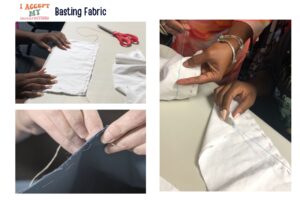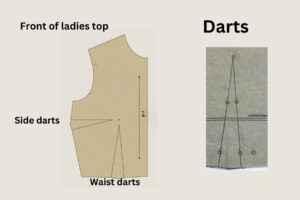Common Sewing Terms and Definitions
Understanding the language of sewing is crucial for your success in this course. Below is a list of common sewing terms that you will encounter throughout the lessons, along with their definitions:
- Backstitch:
A technique used at the beginning and end of a seam to secure the stitches in place by sewing backward over a few stitches.
- Basting:
Temporary, long stitches used to hold fabric in place before permanent stitching. Basting stitches are usually removed after the final stitching is done.

- Bias:
The diagonal direction of fabric, at a 45-degree angle to the grainline. Fabric cut on the bias has more stretch and flexibility.
- Bobbin:
A small spool that holds the lower thread in a sewing machine. It is placed in the bobbin case and works with the upper thread to create stitches.

- Dart:
A tapered fold sewn into fabric to give it shape, commonly used in garments to contour to the body’s curves.

- Ease:
The amount of extra fabric allowed in a garment to provide comfort and movement. It is often added in patterns to ensure a good fit.
- Edge Stitching:
A row of stitching done very close to the edge of the fabric, often used for finishing hems or creating a decorative effect.
- Grainline:
The direction of the fabric threads. There are three types of grainlines: lengthwise (parallel to the selvage), crosswise (perpendicular to the selvage), and bias (diagonal).
- Hem:
The edge of a piece of fabric that has been turned under and sewn to prevent fraying. There are various types of hems, such as double-fold, blind, and rolled hems.
- Interfacing:
A material used to add stiffness or reinforcement to fabric, typically applied to areas that need extra support, such as collars, cuffs, and waistbands.
- Notions:
Small sewing supplies and accessories, such as buttons, zippers, hooks, and elastic, used to complete sewing projects.
- Pattern:
A template or guide used to cut fabric pieces for a sewing project. Patterns can be purchased or self-drafted and often include instructions and markings for assembly.
- Right Side/Wrong Side:
The right side is the front or the side of the fabric that will be visible on the finished project, while the wrong side is the back or inside of the fabric.
- Seam Allowance:
The area between the edge of the fabric and the line of stitching. Common seam allowances are 1/4 inch, 3/8 inch, and 5/8 inch.
- Selvage:
The tightly woven edge of the fabric that runs parallel to the lengthwise grain. Selvages do not fray and are often used to identify the grainline.
- Tension:
The degree of tightness or looseness of the thread when forming stitches. Proper tension is crucial for balanced and even stitches.
- Topstitching:
A row of stitching sewn on the outside of a garment for decorative purposes or to secure seams and edges.
- Understitching:
A technique used to prevent the lining or facing from rolling to the outside of a garment by sewing it to the seam allowance.
- Zigzag Stitch:
A stitch that moves back and forth in a zigzag pattern, often used for finishing edges and preventing fraying.


